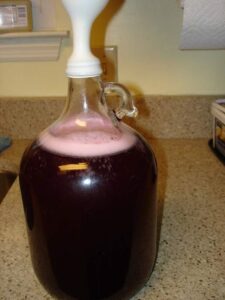
Here are some helpful tips to make your Homemade Blueberry Wine even more delightful:
- Choose High-Quality Blueberries: Select ripe, flavorful blueberries for the best results. Look for fresh, locally grown blueberries when available, or use high-quality frozen blueberries if fresh ones aren’t in season. The quality of the fruit will directly impact the flavor of your wine.
- Balance Sweetness and Acidity: Blueberries can vary in sweetness and acidity, so taste your blueberry juice before adding sugar to determine how much sweetness is needed. You can also adjust the acidity of the wine by adding a small amount of acid blend or lemon juice if necessary. Aim for a balanced flavor profile to enhance the overall taste of the wine.
- Consider Adding Fruit Enhancers: Enhance the flavor and aroma of your blueberry wine by incorporating fruit enhancers such as grape concentrate, elderberries, or black currants. These additions can add depth and complexity to the wine, elevating its flavor profile.
- Experiment with Spices: Add depth and complexity to your blueberry wine by experimenting with spices and flavorings. Consider adding a cinnamon stick, vanilla bean, or cloves during fermentation to infuse the wine with warm, aromatic notes. Be mindful not to overpower the delicate flavor of the blueberries.
- Fermentation Temperature Control: Maintain a consistent fermentation temperature within the recommended range for wine yeast (typically between 65°F to 75°F or 18°C to 24°C). Fluctuations in temperature can affect the fermentation process and the final flavor of the wine. Use a thermometer to monitor the temperature and adjust as needed.
- Proper Sanitization: Ensure that all equipment, including jugs, bottles, and utensils, are properly sanitized before use to prevent contamination and off-flavors in your wine. Use a food-grade sanitizer or a mixture of water and potassium metabisulfite to sanitize equipment thoroughly.
- Aging and Patience: Allow your blueberry wine to age gracefully to develop its full potential. While it may be tempting to sample the wine soon after fermentation, aging improves the flavor and complexity of the wine. Store the bottles in a cool, dark place for several months to a year, or even longer for more complex wines.
- Bottle Variation: Consider bottling your blueberry wine in a variety of bottle sizes and styles for different occasions. Use standard wine bottles for long-term aging, smaller bottles for sharing with friends and family, and decorative bottles for special occasions or gifts.
- Labeling and Presentation: Create custom labels for your blueberry wine to add a personal touch and enhance the presentation. Include information such as the wine’s name, vintage year, and any special notes or ingredients. A well-designed label adds to the overall experience of enjoying your homemade wine.
- Enjoy and Share: Finally, savor the fruits of your labor and share your Homemade Blueberry Wine with friends, family, and fellow wine enthusiasts. Homemade wine is meant to be enjoyed and shared, so pour yourself a glass, raise a toast, and celebrate your winemaking journey!
By incorporating these tips, you can enhance the flavor, aroma, and overall enjoyment of your Homemade Blueberry Wine, creating a delightful beverage to be savored and shared with loved ones. Cheers!
Here are some secrets to help you achieve wine-making perfection:
- Quality Ingredients: Start with high-quality blueberries. Choose fresh, ripe blueberries or opt for premium frozen blueberries if fresh ones are not available. Quality fruit will contribute to the flavor, aroma, and color of your wine.
- Sanitation is Key: Ensure all equipment used in the winemaking process is thoroughly cleaned and sanitized to prevent contamination. Use a food-grade sanitizer and follow proper sanitation practices to maintain a sterile environment throughout the winemaking process.
- Balance Sugar and Acidity: Achieve the perfect balance of sweetness and acidity in your blueberry wine. Taste your blueberry juice before adding sugar to determine the level of sweetness needed. Adjust the acidity with acid blend or lemon juice to achieve a harmonious flavor profile.
- Choose the Right Yeast: Select a wine yeast strain suitable for fruit wines, such as Lalvin K1-V1116 or Lalvin EC-1118. These yeast strains are known for their ability to ferment fruit sugars efficiently and produce clean-tasting wines with good aroma retention.
- Control Fermentation Temperature: Maintain a consistent fermentation temperature within the optimal range for your chosen yeast strain. Fluctuations in temperature can affect fermentation kinetics and the final flavor profile of the wine. Use a temperature-controlled fermentation chamber or cellar to control temperature fluctuations.
- Manage Fermentation Nutrients: Ensure yeast health and vitality by providing adequate fermentation nutrients. Consider adding yeast nutrients such as diammonium phosphate (DAP) and yeast energizer to promote a healthy fermentation process and prevent stuck fermentations.
- Aerate During Fermentation: Oxygenate the wine must during the early stages of fermentation to promote yeast growth and fermentation activity. Stir the must vigorously or use an aeration stone to introduce oxygen and improve yeast health.
- Monitor and Adjust: Monitor the progress of fermentation closely and make any necessary adjustments along the way. Measure sugar levels with a hydrometer or refractometer and adjust sugar additions or fermentation temperature accordingly to achieve the desired alcohol content and flavor profile.
- Rack and Clarify: Rack the wine off the lees periodically to promote clarity and reduce sediment in the finished wine. Use fining agents such as bentonite or sparkolloid to clarify the wine and improve its appearance.
- Age Gracefully: Allow your blueberry wine to age gracefully to develop its full potential. Transfer the wine to clean, sanitized bottles and store them in a cool, dark place for several months to a year, or even longer for more complex wines. Patience is key to achieving a smooth, well-rounded blueberry wine.
By following these secrets, you’ll be well on your way to creating the perfect Homemade Blueberry Wine that’s flavorful, aromatic, and sure to impress your friends and family. Cheers to winemaking success!
